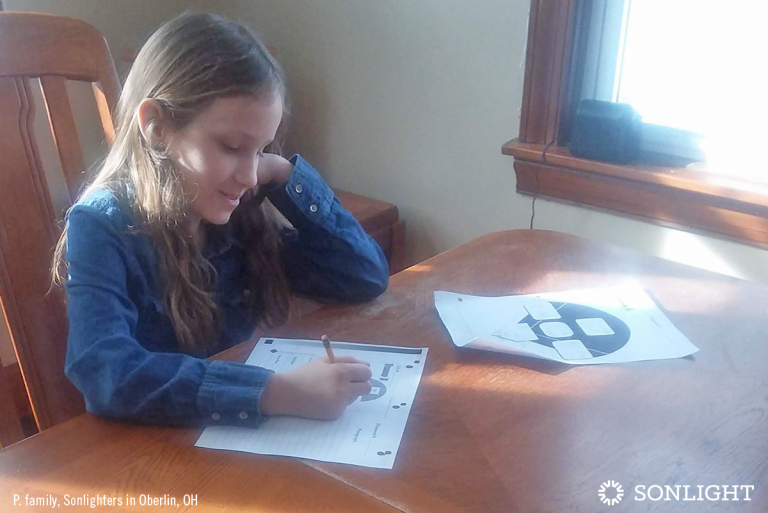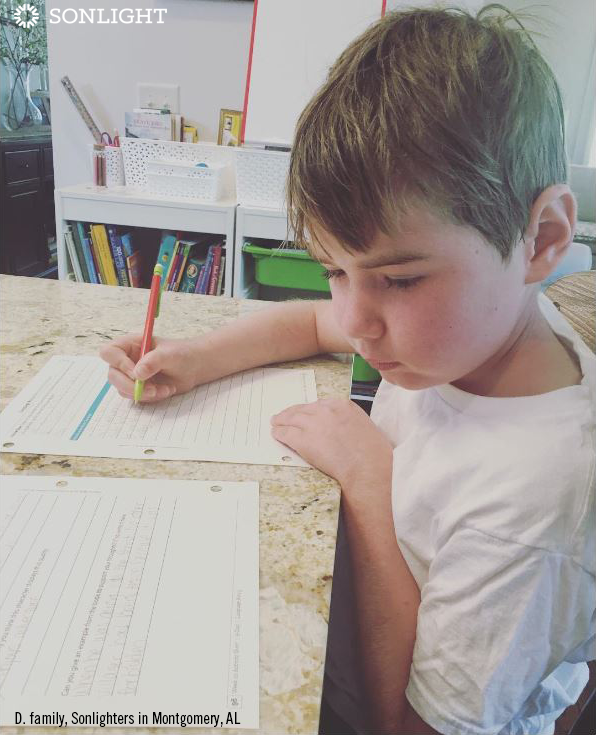Discover ways to encourage reluctant writers to put words on the page and fall in love with writing.

Because writing always felt like a natural way to express myself, I was flabbergasted when I found myself homeschooling students who were extremely reluctant writers! The most I could expect out of them when faced with a blank sheet of paper was a neat spelling of their name. The rest of the paper remained stubbornly empty.
I’ve found that you don’t get very far with teaching rules of formatting or techniques for persuasive language while you’re staring at an empty sheet of paper. So these four suggestions are meant to coax your reluctant writer out of blank page paralysis and into just getting started. Before you can begin helping refine their writing skills, a student simply needs to get comfortable with putting words on paper.
1. Serve as Scribe for the Reluctant Writer
For very young reluctant writers, part of the problem may be simple hand fatigue or the fact that the frustration of trying to form neat letters still creates such distraction that they feel that they can’t accomplish both tasks at the same time: coming up with the right words and then writing them down.
In these early days, suggesting a writing prompt and then taking dictation from your student may help immensely as your student delves into the process of creating original sentences, paragraphs, and stories. As time goes on, you can adapt to writing part of their writing assignment for them, gradually handing over the physical task of writing as they become more confident in the task of composing.
2. Let the Reluctant Writer Write About Personal Interests
One young pupil of mine stubbornly declared he had no interest in writing—nothing! Until I gave him a writing prompt about beetles, at which point, his pencil began flying across the paper. He was passionate about beetles! He studied them and talked about them on a near-constant basis, so he had plenty to say when his writing topic was something he loved.
As a homeschool mom, you are in an excellent position to know your students’ passions, so you can tailor writing prompts according to what they love. We were able to tackle both fiction and non-fiction writing techniques, all while sticking to his beloved topic of beetles:
- Dialogue between a beetle and its mother
- A story in which a beetle faces the consequences of his actions
- Comparison and contrast of a beetle with a different type of insect
- How-to instructional writing on caring for pet beetles
- Sequential description of a beetle’s life cycle
- Sensory description of a beetle’s home environment
He probably wrote over a dozen different types of writing pieces, all relating in some way to beetles. Along the way he discovered that what he had insisted that he was unable to do—sit down and think of something interesting to write—he was, indeed, able to accomplish with excellence.

Charlotte is my third child learning how to write using Sonlight Diamond Notes. This method of teaching writing is so simple and self-explanatory anyone can do it. My older kids have even requested the diamonds when organizing their thoughts for later papers because it helps them remember the basic structure of having a main idea, three key supports, and concluding summary thoughts. It is economical too! We can reuse the main Diamond Notes curriculum again and again! Thanks Sonlight, for another easily accessible and reusable curriculum for families committed to homeschooling their children!
Kendra P. in Oberlin , OH
3. Write Alongside The Reluctant Writer
Some reluctant writers will still be staring off into space, wondering how to get started thirty minutes after you give them a writing assignment. One technique that works in this case is to sit down alongside the reluctant writer with my own notebook and tackle the writing prompt myself! When the allotted time is complete, we can both look over what the other has written.
It’s a little bit like throwing down a friendly challenge which can be a big motivator for some personalities. But it’s also a lot like saying, “Hey, you’re not alone in this. We’ll do it together.” It’s my way of showing the hesitant writer that no prompt is impossible to write about and that writing responses are as unique as the writers who create them. Besides, it becomes a little more challenging to sit and stare off into the distance, doing nothing, when Mom is sitting right next to you, scribbling away as mightily as she can.

Thank goodness for the Diamond Notes system we've learned from Sonlight. We have about 10 weeks left of Language Arts 3 and get a big kick out of looking back at his writing ability at the beginning of the year versus now. Thanks, Sonlight! We love how user friendly Sonlight has been—especially the LA 3 program.
Amanda D. in Montgomery, AL
4. Use Games with the Reluctant Writer
Sometimes you just need to start slow—growing more comfortable with the idea of playing around with words and their spellings and meanings before jumping into full-blown writing. I like to use all sorts of word-related games to get reluctant writers to see how much fun words can be, as a precursor to using words to build stories and essays.
There are all sorts of specialty word games designed to be educational, but I’ve also had great success using classic word games like Boggle, Scrabble, Quiddler, and word searches or crossword puzzles in the quest to increase my students’ comfort level in working with words.
What strategies have helped your reluctant writer battle blank-page paralysis? Share them in a comment below.








